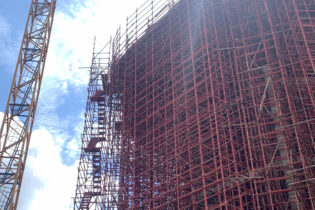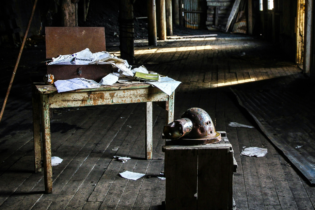Port Elizabeth’s National Sea Rescue Institute (NSRI) rescued 76 people and a dog early on Sunday. The alert that the people, who were attending a religious meeting, were stranded upstream of the Swartkops River, cut off from the mainland by rising water, came at 04h30, the NSRI’s Daniel Heimann said.
 He said because of the water levels and the fact that most of the road had been washed away, a rescue effort by vehicle was impossible. “Our NSRI volunteers found an area that, although barely accessible, was at the time the only way in an out from where the people were,“ he said.
The rescuers, using fallen trees and tree trunks as anchor points, rigged a rope line, making hand rails along the line. Where flood areas were too deep or too turbulent, NSRI rescuers were posted along the rope line to guide and aide the group across the river.
Before the rescue operation began, Heimann said, a safety briefing was held with the fellowship group and each person was allowed to take only one piece of luggage with them.
“Once the group had, one by one, begun crossing the river, our NSRI volunteers helped the elderly and assisted where necessary to get everyone safely across the river.”
He said because of the water levels and the fact that most of the road had been washed away, a rescue effort by vehicle was impossible. “Our NSRI volunteers found an area that, although barely accessible, was at the time the only way in an out from where the people were,“ he said.
The rescuers, using fallen trees and tree trunks as anchor points, rigged a rope line, making hand rails along the line. Where flood areas were too deep or too turbulent, NSRI rescuers were posted along the rope line to guide and aide the group across the river.
Before the rescue operation began, Heimann said, a safety briefing was held with the fellowship group and each person was allowed to take only one piece of luggage with them.
“Once the group had, one by one, begun crossing the river, our NSRI volunteers helped the elderly and assisted where necessary to get everyone safely across the river.”Meanwhile, rain continued to cause havoc in the Eastern Cape on Sunday, with parts of the N2 closed to traffic, Eastern Cape disaster management said.
“There is a huge hole, about 25m wide and 50m deep on the N2, by the Pumba Game Reserve, between Port Elizabeth and Grahamstown,” said Captain John Fobian. “The road has been closed off and traffic is being diverted from Port Elizabeth to the Cradock Road N10 around Cookhouse and back to Grahamstown or East London.” The SABC reported that Kouga municipality spokesperson Laura-Leigh Randall said the Sand River bridge between Cape St Francis and St Francis Bay had been washed away and the water was still strongly flowing. According to the broadcaster, she said a technical team had assessed the damage and said it would not be possible to construct a pedestrian bridge, but that people were crossing the river where the water was flowing less strongly. Source: SAPA






